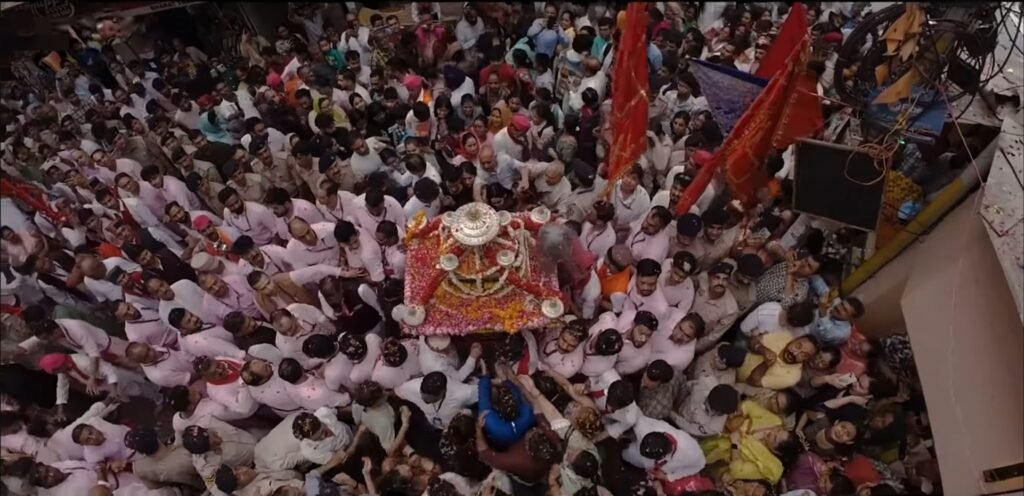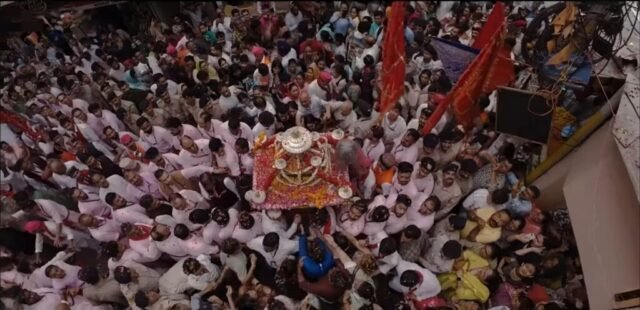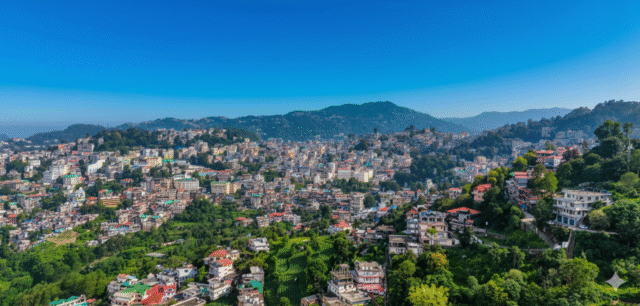Introduction
The Mushroom City of Himachal Pradesh—Solan is known for its serenity, green hills, and folk culture. The spiritual heart of this town is the Shoolini Mata Temple, without which the identity of Solan is considered incomplete.
According to local beliefs, the very name Solan is connected to Maa Shoolini—ancient folk songs like “मैं ता जाई लेणा सोलनी बजार…” and “सोलनी पड़ी गई छौणी…” make this faith even stronger.
Every year, around the second Sunday of the month of Ashadha (usually the Sunday after the third Sunday of June), the divine celebrations of the Shoolini Mela fill the town—
- the grand palanquin (palki) of the Goddess,
- the sounds of drums and shehnai,
- thousands of devotees in a procession,
- hundreds of community feasts (bhandaras),
- cultural programs,
- and the mysterious ritual called Khumri, where the Goddess is asked: “Do you accept the fair or not?”
In this divine atmosphere, devotees say that as soon as they enter the temple premises, they feel a unique sense of peace, energy, and protection.
The history of Solan is equally fascinating—this part of the Baghat princely state represents a wonderful blend of tradition × modernity. Nearby, in Jaunaji, the famous Chaturbhuj Narayan Temple (family deity of the Panwar dynasty) and the legend of Lugasan Mata (Kuldevi) continue to be part of people’s lives even today.
👉 This visitor guide brings everything together for you—history, legends, the fair, Khumri ritual, the two temple traditions, timings, how to reach, tips, and nearby attractions—so that you can experience Shoolini Mata Temple with the right context and reverence.
History & Legends of Shoolini Mata
1) Origin of the Name (Etymology & Cultural Memory)
According to local tradition, the name Solan comes from Shoolini/Solni. Literary references like “म्हारा बघाट सोलन” and folk songs firmly connect the town with the Goddess. In the Durga Saptashati, the form of Shooldharini (Trinetra Shooldharini) is described—this is Shoolini, the presiding deity of the Baghat State. Hence, the lineage “Solni → Shoolini → Solan” remains alive in cultural memory.
2) Baghat State, Panwar Dynasty & Jaunaji’s Vishnu Temple
During the Mughal invasions, the Panwar dynasty moved towards the hills with their family deity Chaturbhuj Narayan. A divine dream instructed them to recover an idol hidden in a pond and consecrate it with Vedic rituals. Later, an idol was brought from Dharanagari (Madhya Pradesh) and installed at Jaunaji—today known as the Chaturbhuj Narayan Temple, the main Vishnu temple of the region. The site where Jaunaji Senior Secondary School now stands was once considered the king’s palace. Even today, descendants of the Panwar dynasty visit and perform their traditions here, linking Solan’s history with royalty, devotion, and sacrifice.
3) Lugasan Mata—The Miraculous Manifestation of the Kuldevi
Local tradition narrates that Lugasan Mata manifested beneath a ber tree. When the idol was unearthed, it was accidentally damaged and a stream of blood flowed from it, terrifying everyone. The king felt guilty; many goldsmiths were invited but none could restore it. Finally, special artisans from Ambala placed mirrors behind the idol to give it a complete form. Since then, Lugasan Mata has been worshipped as the Kuldevi of the Panwar dynasty, a story that holds a central place in Solan’s cultural and religious memory.
4) The “Real” Shoolini Temple—Two Traditions, One Faith
In Solan, the Shoolini tradition is connected with two major sites:
- Solan Village Temple (Shoolini/Lugasan): Linked with the king’s dream and consecration—considered the “main” temple by many.
- Ganj Bazaar Peetham/Durga Mata Temple: Here natural pindis of Shoolini and Shiva are worshipped; many priestly families regard this as the “true Peetham.”
Both traditions are complementary. Local society considers visiting both shrines auspicious, and Shoolini Mata is worshipped in various forms of Durga. This plurality of traditions gave Solan a spirit of harmony and co-existence.
5) The Legend of the “Seven Sisters” (Shakti-Sisters Motif)
According to a folk belief, Shoolini Mata is one of the “seven sisters” which include Jethi Jawalaji, Hinglaj Devi, Lugasan Mata, Naina Devi, Tara Devi, and others. This Shakti-Sisters motif is common in the Himalayan belt, where each shrine worships Durga in a unique form, with rituals adapted to local traditions.
6) Foundation of the Fair—From Royal Tradition to People’s Festival
Historical accounts link the Shoolini Fair to different rulers—some to Raja Dilip Singh (as thanksgiving after an epidemic ended), others to Raja Durga Singh or even earlier. The essence remains that Baghat rulers organized the fair to please their Kuldevi Shoolini Mata, believing that if the Goddess is pleased, disasters stay away and prosperity continues.
In modern times, after Solan became a district in 1972, the fair was declared state-level and extended from a one-day event to a three-day grand festival, keeping heritage alive and promoting tourism.
7) Modern Era—Management, Security & Preservation
Around 2007, with rising popularity, the temple came under government administration, while rituals are still conducted by traditional priests. During this period, the shock of idol theft shook the community, but with unshaken devotion, the idol was re-consecrated and the divine flow re-established.
Some customs also changed with time. For example, earlier on the birth of a son, devotees offered a goat sacrifice, while today the offering has transformed into a kadai (sweets), coconut, and ₹1100. The sentiment remains the same, though the form has modernized.
Shoolini Mela – Faith, Rituals & Grand Celebration
The Shoolini Mela, held every year on the second Sunday of Ashadha month, is the soul of Solan. It is not just a religious celebration but a living symbol of folk culture, brotherhood, and tradition. Some traditions connect its origin to Raja Dilip Singh or Raja Durga Singh—some as thanksgiving after an epidemic, others saying that the Goddess herself appeared in a dream and ordered that her worship and procession take place every year.


From Early Form to Modern Times
- Initially, the fair was a one-day event, held in fields near the Ganj Bazaar temple.
- Its main attractions were wrestling matches and the Thodo dance (a martial folk dance).
- Even great wrestlers like Dara Singh once participated here.
- After Solan became a district in 1972, the fair was declared state-level and expanded to three days.
- Today, it is held at the Thodo Ground, with folk dances, sports, cultural evenings, and hundreds of shops.
Palankeen Yatra
The fair begins on Friday with the Palankeen Yatra. The Goddess’s palanquin starts from the Solan Village Temple and passes through Chowk Bazaar → Ganj Bazaar → Upper Bazaar → Old Bus Stand → Old DC Office → Ganj Bazaar Temple.
This temple is considered the resting place of the Goddess, where she stays for three days. On Sunday, the Palankeen returns via the Durga Temple to the Solan Village Temple.
During this time, the entire town fills with devotion, music, chants, and flower-decked celebrations.
Two Major Idols in the City Procession
Only two idols are taken out for the procession:
- Shoolini Mata
- Lugasan Mata
Other deities like Dev Mali and Shirgul Maharaj remain in the temple as symbols of mysterious powers.
Karene / Kalyan – The Right to Carry the Palankeen
Only the Kare-ne (Kalyan) villages—22 villages whose Kuldevi is Shoolini Mata—have the right to carry the palki. Seven days before the fair, they begin a strict fast:
- sleeping on the ground,
- staying away from household or business work,
- devoting themselves fully to the Goddess.
During this time, even their families follow strict rules—for example, women do not visit other homes.
Khumri – The Most Mysterious Ritual
On Saturday, the most important ritual, Khumri, takes place. Through the Gur (medium), the Goddess is asked whether she accepts the fair.
- If something is wrong, the Goddess scolds.
- If everything is right, she blesses the devotees.
- When the Gur cannot sit on the ritual seat (e.g., in case of family mourning), the Bhandari, Kathari, Sarjai, Pujari, and priests jointly declare: “The fair is accepted.”
Afterwards, rice from the havan is distributed among devotees. Only those who kept the three-day fast may participate.
👉 A remarkable event occurred in 2010, when the Goddess did not accept the fair, and a one-day special ritual had to be performed again. This memory still lives strong in people’s hearts.
Games, Stalls & Cultural Nights
The fair today is grand and diverse:
- Sports competitions like tug of war, kabaddi, volleyball.
- Hundreds of temporary stalls of swings, toys, handicrafts, and food.
- Cultural evenings with folk artists from Himachal and other states.
- Sometimes even film celebrities attend—
In 2025, performances by Indian Idol winner Sunny Hindustani, Dalip Sirmauri, and Neha Dixit made the fair unforgettable.
Bhandaras – Service & Devotion Together
The soul of the fair lies in the Bhandaras (community feasts). For all three days, hundreds of free food stalls are set up. Anyone, even without money, can eat here. Each plate carries the taste of love, service, and devotion. That’s why people say this is the one fair in Himachal where no one remains hungry.
The Magical Nights
The nights of the fair feel like a dreamland:
- The whole town of Solan glitters with lights.
- Every street and lane is decorated.
- The air is filled with chants, devotion, and the fragrance of faith.
Why is the Fair Special?
The Shoolini Fair is more than a religious celebration—it is a cultural festival that binds people with faith, tradition, and brotherhood.
It is the meeting point of past and present, the thread that unites society, and most importantly—
👉 the true identity of Solan.
Shoolini Mata Temple Darshan Timings
Mata Shoolini’s temple is located in the center of Solan and remains open for devotees throughout the year. Darshan timings are generally as follows:

- Morning Opening Time: 5:00 AM
- Evening Closing Time: 9:00 PM
- Morning Aarti: approximately 6:00 AM
- Evening Aarti: approximately 7:00 PM
During festivals—especially during the Shoolini Mela—the temple timings and darshan arrangements may be changed, because the number of devotees increases many times over.
👉 Pro Tip: If you want to have darshan in peace, the early morning aarti is the best time. The evening aarti is also very enchanting, when lamps, bells, and resounding chants make the atmosphere even more sacred.
Best Time to Visit Shoolini Mata Temple
Solan’s weather is pleasant throughout the year, but for darshan of the Goddess and to experience the fair, some specific times are considered best:
- March to June (Spring–Summer): The weather is pleasant and the crowds are not too heavy. In June, the Shoolini Mela is organized, which makes this period the most special.
- September to November (Autumn): With clear skies and cool breeze, this season is ideal for travelers.
- December to February (Winter): The cold can be intense, but if you want to experience the winter of Himachal, this is also a good time.
- July–August (Monsoon): There is considerable rainfall during this time and roads become slippery. If you want a safe and comfortable journey, it is better to avoid this season.
👉 Travel Hack: If you want to experience devotional ambience and cultural vibrancy, come during the Shoolini Mela in June. But if you want peace, choose March–April or October–November.
How to Reach Shoolini Mata Temple
Shoolini Mata Temple is located right in the middle of Solan and is easily accessible. There are several easy options to reach here:
By Road
- Solan lies on NH-5 (National Highway Chandigarh–Shimla).
- Chandigarh to Solan: ~65 km (about 2 hours).
- Shimla to Solan: ~45 km (about 1.5 hours).
- From the Solan Bus Stand, Shoolini Temple is only a few minutes away.
By Train
- Solan Railway Station (on the Kalka–Shimla heritage toy train route) is the nearest station.
- From Chandigarh, you can take a broad-gauge train to Kalka and then reach Solan by the toy train.
By Air
- The nearest airport is Chandigarh International Airport (~70 km).
- From there, you can easily reach Solan by road travel.
Local Transport
- Auto-rickshaws and cabs are available to reach the temple.
- Since the temple is close to Mall Road and the City Center, you can also walk comfortably if you wish.
👉 Pro Tip: If you are visiting Solan for the first time, carry light clothing and comfortable shoes. During monsoon, don’t forget to carry an umbrella and raincoat.
Visitor Tips for Shoolini Mata Temple & Fair
Visiting Shoolini Mata Temple and the annual fair is a spiritual and cultural experience. But if you are coming for the first time, following some tips and etiquette will be helpful:
✅ Do’s
- Early Morning Visit: Participating in the morning aarti offers the most peaceful and sacred experience.
- Respect Traditions: Respect the rules of the Kare-ne (the families who carry the palanquin) and other religious sevaks. There are strict rules about going near or touching the palki—do not violate them.
- Dress Modestly: Since this is a religious place, wear simple and modest attire.
- Carry Cash: Around the temple there are many small stalls and bhandaras—digital payment may not be available everywhere.
- Participate in Bhandara: It is a symbol of service and devotion—food here is not just to fill the stomach but a part of the shared culture.
❌ Don’ts
- Avoid Alcohol / Smoking: Completely forbidden in the temple premises and during the mela.
- No Drone Without Permission: For cultural and religious events, obtain permission from local authorities before using a drone.
- Avoid Crowd Pressure: During the palanquin procession, avoid pushing and jostling in the crowd.
Travel Hacks
- If you want to avoid crowds, come in months other than the mela.
- For parking issues, use official parking near Mall Road—during the mela, private vehicles may have to be parked quite far away.
- Book hotels in advance during the mela because the entire city fills up with visitors.
Our Experience with Shoolini Mata
Before moving to Solan, I used to live in Shimla and often heard stories about Shoolini Mata Temple — how Solan is named after Shoolini Devi, how every year the Shoolini Mela is celebrated, and how people here believe She protects the town like a mother. At that time, I only knew Shoolini Mata through people’s stories — not personally.
Almost two years ago, when I shifted to Solan, I visited the Shoolini Mata Temple for the first time. The moment I stepped inside, I felt a strong spiritual energy — calm, powerful, and welcoming. From that day, I felt connected to Shoolini Mata in a way that cannot be described in words.
Now, before I start any new work — whether it’s content creation, my profession, or even a small decision — I first remember Maa Shoolini. It has become a part of my life. I genuinely feel that whatever I have received in Solan today — respect, work, opportunities, love from people — all of it is somewhere because of Her blessings.
This is the reason I decided to make a Shoolini Mata Documentary on YouTube, and now I decided that we writing this Shoolini Mata Blog, so that more people can know about Shoolini Mata’s history, temple, traditions, and miracles — not just as a deity, but as a living emotion in Solan.
Nearby Attractions from Shoolini Mata Temple
Solan is not just a religious center but also a full-fledged travel destination. If you come here, you can also explore these nearby places:
1. Jatoli Shiv Temple (7 km)
- Considered Asia’s tallest Shiv Temple.
- Dravidian-style architecture and a cave-style pradakshina path attract visitors.
- A blend of religious and architectural beauty.
2. Mohan Shakti National Heritage Park (12 km)
- India’s first heritage park—showcasing India’s history and dharma in one place.
- Grand statues, beautifully landscaped gardens, and a serene environment.
3. Karol Tibba Trek (7 km)
- One of Solan’s most popular short treks.
- Known for the ancient Pandava cave and scenic nature trails.
4. Thodo Ground (2 km)
- The main venue where the Shoolini Mela is organized.
- Famous for the Thodo dance and sports competitions.
5. Solan Mall Road
- Perfect for local shopping and food stalls.
- You can buy Himachali woollens, handicrafts, and daily-use items here.
6. Bon Monastery, Dolanji (25 km)
- World headquarters of the Bon religion.
- Experience Tibetan architecture and morning–evening chanting.
Shoolini Mata Temple Location, Photos & Videos
YouTube Video: Given To the end of the blog – KKSB Vlogs
Instagram Updates: Stay connected with us for reels and updates– @official_kksb
Shoolini Mata Temple Photos
Youtube Video Of Shoolini Mata
Shoolini Mata Temple Location
❓FAQs about Shoolini Mata Temple
Which is the real temple of Shoolini Mata?
There are two major places in Solan: the Solan Village Temple (where the traditions of Lugasan Mata and Shoolini Mata are connected) and the Ganj Bazaar Peetham / Durga Temple (where the self-manifested pindi is enshrined). Both places have their own significance, and locals worship both as Shoolini Mata.
When is the Shoolini Mela held and for how many days?
very year the fair is celebrated on the second Sunday of the month of Ashadha (usually after the third Sunday of June). Since 1972, it has been celebrated for three days.
What is the route of the palanquin procession?
On Friday, the palanquin procession starts from the Solan Village Temple and goes via Chowk Bazaar → Ganj Bazaar → Upper Bazaar → Old Bus Stand → Old DC Office to reach the Ganj Bazaar Temple. On Sunday, the palanquin returns to the Solan Village Temple.
What is the Khumri ritual?
It is the most mysterious part of the fair. On Saturday, the Goddess is asked through the Gur (medium)—“Is the fair accepted?” If everything is right, the Goddess praises, otherwise scolds. In 2010, once the Goddess did not accept the fair, and a special one-day ritual had to be performed again.
Who are the Kare-ne/Kalyan?
They are the people from the 22 villages whose Kuldevi is Shoolini Mata. They alone have the right to lift the palanquin. They observe a three-day fast, sleep on the ground, and dedicate their lives entirely to the Goddess’s service during this period.
What is special in the Shoolini Mela?
The palanquin procession, Khumri ritual, Thodo dance, wrestling, sports competitions, cultural evenings, swings, handicrafts, and above all—bhandaras. This is a fair where no one remains hungry.
What are the temple darshan timings?
Every day from 5:00 AM to 9:00 PM. The morning and evening aarti are considered special.
What is the easiest way to reach here?
From Chandigarh via NH-5 in 2 hours and from Shimla in 1.5 hours you can reach Solan. Solan Railway Station (toy train route) and Chandigarh Airport (70 km) are the nearest connections.










